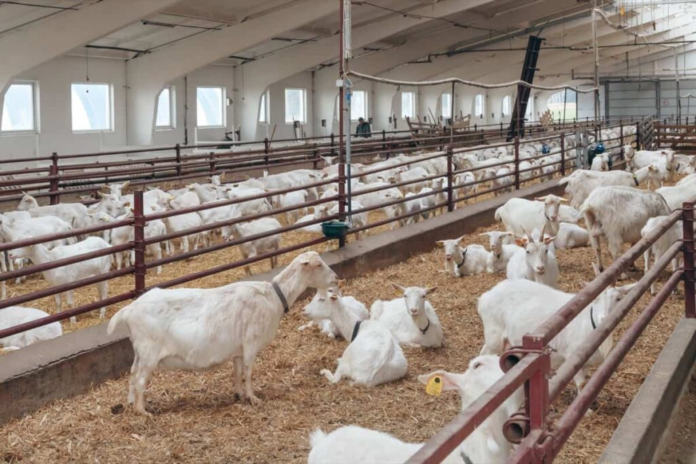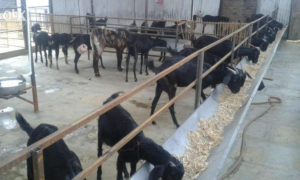CONSTRUCTION AND DESIGNING OF HOUSING FOR COMMERCIAL GOAT FARMS
Pooja Tamboli*, Nishtha Kushwah, A. K. Chaurasiya, Purushottam Sharma and K. K. Singh
Indian Grassland and Fodder Research Institute
Jhansi- 284 003 (U.P.), India
* Corresponding author: tamboli.pooja307@gmail.com
Introduction
As a part of agriculture in our country, the livestock business is continuously growing. In addition, livestock husbandry helps resource-poor families to secure their livelihoods. Another good way for poor people to make a good living standard is by raising small ruminants like sheep and goats. Because of this a goat is also called a “poor man’s cow” People raise small ruminants for their meat, wool, hair, and skin. The goat is also raised for its milk, which is both nutritious and useful for medical reasons. India has the most animals of any country (536.76 million), and it has the second most goats (148.88 million), which is 10.1% more than it did in the last census. The goat makes up about 27.74 percent of all the animals in our country. They are one of the main animals raised for meat in India. Their meat, called chevon, is one of the best and is in high demand in the country. For commercial purposes, raising goats in intensive and semi-intensive systems has been growing in popularity over the last few years because it’s a good way to generate money. Many forward-thinking farmers, entrepreneurs, individuals and other educated youngsters are starting goat farms on a large scale because there is a high market for goat products and they can make substantial profits from them. In addition, businesses are interested in the new, good market conditions and how easy it is to get better goat technologies. A lot of industrial goat farms have been set up in different parts of the country. Another thing to note is that goat farming for earnings is becoming more and more famous in India with each passing day. Goat farming has been shown to be a very profitable business idea, so this type of business is becoming more and more popular in India very quickly. Chevon, or goat meat, is the most popular and widely eaten meat in the country. Because it is similar to human milk and therefore easier to digest, goat milk has been used for medicinal purposes for a very long time. Recently, it has become more important in human health because of its many health-promoting qualities. In the next few years, there will likely be more demand for goat milk and milk products, both for domestic use and for sale. Millions of small and poor farmers in the country see goat farming as a way to create jobs, make sure they have enough food, and get ahead financially. One of the most important parts of goat farming is the housing for the goats. Before buying goats from the market, you should make plans for how he will live. Their homes are usually places where they can stay safe from bad weather like rain, too much heat in the summer, and cold weather in the winter, as well as from attacks by animals that are bigger than them. To make sure they get the right care and handling, goats need to be housed separately for different types of animals, such as growers, adult females, breeding males, and so on. Sheds or other goat housing are typically the first major purchase in the goat farming industry. What kind of shed or house you need is based on how many goats you have on your farm. To begin, only build as many homes as you need. As the farm grows, you can add sheds as needed. Put the animals in the house into groups based on their ages. Prior to buying goats from the market, make sure their house and feeds are set up correctly. On the farm, you should always have a hold area. Building the goat shed should depend on the goats’ location or the weather.
Goat housing in India
In order to maximize earnings, it is crucial to provide adequate accommodation for goats in an intensive system of production. The primary objective of animal housing is to shield animals from the effects of environmental stress and climate extremes. The animals’ environment consists of the physical space around them. Both the immediate microenvironment and the macro environment that the animal is a part of play, a role. Similarly, weather conditions, or climate, are the result of a complex interplay between a numbers of meteorological variables. All of these parts must work together to give animals the comfort they require. New diseases have entered the animal production system as a result of the shift in temperature and the unusual pattern of rainfall. Although control housing may be the answer to these issues, it is now too costly to implement. In India, there hasn’t been nearly enough systematic research done on goat housing. The fundamental concept, then, is to regulate various aspects of the weather to place them inside a zone where goats are comfortable. In the colder month of January, for instance, farmers should install heat convectors or heaters within their farms, while in the warmer months of May and September, they should set up coolers.
Region
Goat rearing is highly successful in nearly every region of India. Goat farmers have their pick of either land convenient to their homes or land outfitted with everything necessary to run a prosperous goat farm.
General measures:
- The chosen farm location is close to a suitable market with high demand for goat products.
- Land near a town is a good choice. Because land and labor may be found in plenty and at low cost in rural locations.
- The chosen plot won’t be too distant from human settlements.
- Easy access to the local town or market to sell your wares and stock up on necessities thanks to the reliable public transportation system.
- Find a piece of land with access to plenty of pure water.
- Good for growing grass, crops, and other greenery. Goats eat this to cut back on the price of supplemental feed.
- In a place with good drainage
- Make sure there is a grocery store or pharmacy close by so you can stock up on essentials.
- Ensure availability of all sorts of veterinary service in the area. If they are not already in stock, make sure your farm has access to the necessary immunizations and medications.
- Investigate to see if there are any further goat farms in the region.
Orientation
By aligning the stall’s longitudinal axis east-west, one may stop the sun from overheating the enclosure. In the conditions of north India, it is advised.
Ventilation
To maintain the ideal internal temperature of 28 to 30°C, ventilation is crucial. Animals will consume less and produce less if they are unable to expel heat due to an environment that is too hot (over 30°C). The majority of pneumonia cases are associated with interior spaces that are overly warm and humid as well as abrupt temperature swings. Therefore, it is essential to build the shed tall enough and to ensure that the walls or roof include ventilation apertures.
Materials
In Indian conditions, a solid brick wall with a galvanized wire net is ideal. Buildings of this caliber are costly to construct, yet for a variety of reasons, their necessity cannot be denied. For low-height sheds, asbestos roofing is required, while fiber sheds may be utilized for high-height sheds. Metal roofs should always be avoided since they quickly warm up and cool down in the summer and winter, respectively. Under such circumstances, it is challenging to create the optimal environment inside the goat house.
Wall:
Enough ventilation can be achieved by adding apertures or short side walls that are between one and 1.5 feet high. This purpose can likewise be served by a hedge. Inner walls help with animal management, such as regulating reproduction, while outer walls shield animals from outside influences. Inner walls should at the very least establish separate pens for males, females with young, and females without young. Weaned young, young males of breeding age, young females of breeding age, and an isolation enclosure for sick animals are other pens that should be built. Building a paddock or yard next to the shed is another option for providing an area for animals to exercise, eat, and drink.
Floor:
The floor could be made of concrete, slatted flooring, or packed soil. For optimal drainage, packed earth or concrete floors should have a slope of roughly 5% (1:20). Goats can also benefit from elevated platforms where they can lie above the ground and away from feces and dung. These can be arranged along the barn’s longest wall. While slatted floors are better for hygiene and are less likely to cause disease, their high cost prevents large farms from using them. Elite flocks could be effectively maintained in breeding farms by using it. Raising slatted flooring to a height of one to one and a half meters above the ground will make cleaning and removing waste and urine easier. To facilitate the simple flow of fecal material and ensure the animals have secure footing, the spacing between the slats should be between 1.4 and 1.6 cm. It is not advisable to place newborns or young lambs on slatted flooring.
Roof:
Thatch, tiles, cemented sheets, or thermally insulated GI sheets can be used for the goat house’s roof, depending on what is available and how durable it needs to be.
Floor space requirements:
Recommended floor space requirements for Indian conditions
| Age groups | Covered space (sq.m) | Open space (sq.m) |
| Up to 3 months | 0.2-0.25 | 0.4-0.5 |
| 3 months to 6 months | 0.5-0.75 | 1.0-1.5 |
| 6 months to 12 months | 0.75-1.0 | 1.5-2.0 |
| Adult animal | 1.5 | 3.0 |
| Male, Pregnant or lactating ewe/ doe | 1.5-2.0 | 3.0-4.0 |
Floor space requirement per animal (BIS standard)
| Types of animals | Minimum floor space per animal (sq.m) |
| Ram or buck in groups | 1.8 |
| Ram or buck – individual | 3.2 |
| Lambs or kids – in group | 0.4 |
| Weaner in groups | 0.8 |
| yearling or goatlings | 0.9 |
| Ewe or doe in groups | 1.0 |
| Ewe with lamb | 1.5 |
Feeding and watering space requirement
| Type of animal | Space per animal(cm) | Width of manger/
water trough(cm) |
Depth of manger/
water trough (cm) |
Height of inner wall ofmanger/
water trough (cm) |
| Sheep and goat | 40 – 50 | 50 | 30 | 35 |
| Kid/lamb | 30 – 35 | 50 | 20 | 25 |
Different structures should be present in an organized sheep and goat farm
The sheds of the following types are required for scientific housing:
- General flock shed (Ewe / Doe shed)
- Ram or buck shed
- Lambing or kidding shed
- Lamb or kid shed
- Sick animal shed
- Shearing and storeroom
- Attendant’s room
General flock shed (Ewe / Doe shed)
- Ewes or does kept for breeding purposes must be housed in the flock shed.
- The shed’s dimensions are 15 m (l) x 4 m (w) x 3 m (h), and it can hold up to 60 ewes or does.
- The shed should have a brick-on-edge floor and stand three meters tall.
- The flooring should ideally be raised in locations with low elevation and frequent rainfall; in temperate climates, they could be constructed of sturdy wood.
Ram / buck shed
- In these sheds, bucks or rams kept for breeding are housed individually. As an alternative, larger sheds can be divided into stalls by raising wooden dividers.
- With dimensions of 4 m (l), 2.5 m (w), and 3 m (h), it can hold approximately 3 rams or bucks.
- The shed needs to be divided into three equal sections longitudinally.
- The distance between any two sheds should not be greater than one meter.
- Either half-cut ballis or hardwood planks may be used for the partitions.
- The height of the partition above the floor must not exceed one meter.
Lambing / kidding shed
- Pregnant does or ewes will be housed separately in these shelters and utilized as maternity rooms.
- The shed will measure 1.5 m (l) by 1.2 m (w) by 3.0 m (h). It will have a manger to store feed and hay as well as a bucket to hold water.
- These sheds need to be cleared of drafts.
- Maternity pens in colder climates should have a warming device, such as a room heater, installed to keep newborns warm during the winter.
Lamb/ kid shed
- These sheds hold lambs or kids from the time of weaning until they reach adulthood, with roughly 25 animals per shed.
- Lambs who are unweaned, weaned but immature, and those that are close to maturity can all be housed separately in a larger shed by building the necessary partitions.
- Larger farms, on the other hand, would build three distinct shelters to house three different kinds of youngsters or lambs.
- The shed’s dimensions should be 7.5m (l), ×4m (w), ×3m (h) in order to hold a maximum of 75 animals.
- The shed will be divided into two sections by a width divider. The unweaned animals will be kept in compartments measuring 5 m (l), × 4 m (w), × 3 m (h), whereas the weaned animals will be kept in another compartment measuring 2.5 m (l), × 4 m (w), x 3 m (h).
Sick animal shed
- A sick animal shelter will be provided for the isolation of sick and impaired animals.
- One or more ill animal sheds measuring 3 m (l), 2 m (w), and 3 m (h) may be built apart from the other sheds.
- Wooden planks may be used for the lower part of the door and wire netting for the upper half.
- Additionally, a window with a wire net covering that is 0.7 m wide and 1.2 m high might exist.
Shearing and storeroom
- There is a partition separating the two sections that make up the shearing and storeroom.
- Feed and medication storage might be done in one area and wool and shearing equipment storage in another.
- 6 m (l) x 2.5 m (w) x 3 m (h) might be the dimensions of the additional shearing chamber.
- On the front side of the room, there will be a door that is one meter wide and two meters high.
- Timber battens could be used to make the door leaf. Additionally, it might contain two windows—one on each of the room’s long sides.
- The walls and floors in this room should be glazed tiles up to a height of 1.5 meters, and the floors should be spotless and smooth.
- Dust and moisture should be removed from the room.
- Three windows on three sides are required.
Room of the attendant
- The caretaker’s shepherd’s cottage should be situated in the yard at a handy location.
- The house could be 6 m (l) by 4 m (w) by 3 m (h). On the long side of the shed facing the yard’s passageway, there will be a door measuring one meter in width and two meters in height.
- The door leaf could be made of planks of wood. Four windows could be present, three of which face outside and one towards the yard’s passage.
- Each window may have wire netting covering it and measure 0.7 m wide by 1.2 m high.
Dimensions of different sheds in a sheep and goat farm
| Name of the shed | lx w x h (m) | No. of animals Housed | Remarks |
| Ewe/ doe shed | 15 x 4 x 3 | 60 | |
| Ram/ Buck shed | 4 x 2.5 x 3 | 8 | Make partition length wise |
| Lamb/ kid shed | 7.5 x 4 x 3 | 75 | Make partition width wise |
| Lambing/ kidding shed | 1.5 x 1.2 x 3 | 1 | Provide manger and waterer |
| Isolation / sick animal shed | 3 x 2 x 3 | 1 | Provide proper ventilation and beddingmaterials |
| Shearing shed | 6 x 2.5 x 3 | 1 | Make arrangement for storage of wool |
| Shepherd house | 6 x 4 x 3 | – | It should be located nearer to flock |
| Milch doe shed | 1.2 x 0.8 x 3 | 1 | – |
Units
Constructional details of different units
Floor
- There are two types of flooring: moorum and strong wooden battens. If it rains a lot, the stronger wooden battens may be better.
- When it comes to wooden batten flooring, each plank should be between 7.5 cm and 10.0 cm wide and between 2.5 cm and 4 cm thick.
- The planks’ edges must be well rounded, and there must be at least 1 cm of space between each pair of planks to make it easier to clean up dung and pee.
- At least one meter must be added to the height of the wooden board flooring above the ground.
- Then there should be a ramp or steps made of wooden pieces that are right for the situation.
- It is required that moorum floors have a base wall that is between 15 cm and 30 cm high.
- The floor of the cutting and storage room, as well as the shepherd’s house, can be made of moorum or bricks set in cement mortar, and it must be level.
Roof
- You can add gables to the roof.
- Galvanized steel sheets that are flat or curved, asbestos cement sheets, or thatch may be used for roofs that don’t get too much rain.
Gate
- One or more gates can be added to each shed on either the long or wide sides, based on the size of the shed.
- The width of each gate can be 0.8 m and its height can be 1 m. Logs of wood can be used to make the gate leaf and frame. It will fit the doorway very well.
Manger
- The manger, which has two sections for hay and feed, can be made of wood or cement concrete.
- You can also give the animals with a separate hay rack that is fixed at or slightly below their heads.
- The manger may be elevated to a height of between 450 and 600 mm off the ground by using clamps.
- The water trough can be fixed or suspended from a hook fastened to the walls. It can be made of cement concrete or galvanized steel buckets or pails.
- Another option for the manger is a portable one. Depending on how many animals are housed in each shed, the quantity of mangers and water troughs may change.
Dipping Tank
- In order to keep the animals from getting sick, a dipping tank can be made of stainless steel sheets, stone or brick in cement mortar, or whatever material is most cost-effective in the area.
- If a galvanizing steel tank is used, it needs to be well padded down and squished against the ground so that the sides of the bath don’t bulge when it’s full.
- It is possible to put cement concrete under the tank if the ground beneath it is weak.
- The diving tank could be in the yard on one side.
Footbath:
At the opening to the yard, there must be a footbath made of galvanized steel sheets or bricks set in cement mortar to keep the animals from getting foot-rot. These baths can be buried in the ground in the right way.
Goat farming housings designs & plans
Ground floor shed Plan
These are the most common types of sheds in the north and west of India, or in places that don’t flood. For beginners, these kinds of sheds didn’t require a lot of money. To keep these sheds clean for the goats, they should be cleaned two or three times a day. This is the most common plan for a ground-floor goat house around the world.
Elevated Goat housing Plan
This style of goat living is especially important in areas that get a lot of rain or flood. This is a plan for a raised goat house. This type of shed stays clean and germ-free because goat dung falls to the floor, leaving the shed always dry. Goats also don’t like wet floors, so this type of shed is good for goats.
Cleaning and sanitization:
- Cleaning the shed should be done three times a day.
- Washing the shed should be done twice a week.
- Applying lime powder and dewormer to the shed once a month.
- Whitewash borders to add color.
- Every three months, burn the shed to eradicate microorganisms.




